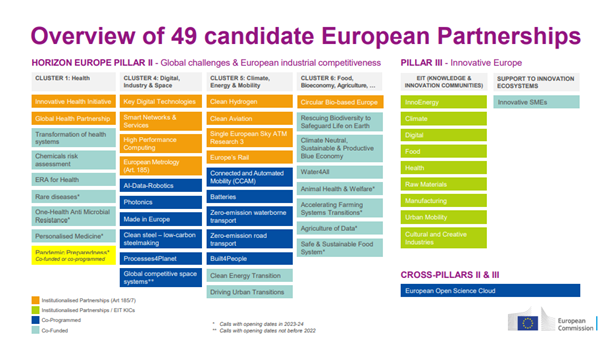News |
Research and Innovation Partnerships: a key component of a successful EU positioning strategy17/3/2022 European Research and Innovation Partnerships play an essential role in defining research and priorities in strategic areas of interest to the EU. Understanding the landscape of partnerships may allow you to make a difference better position your company and increase your participation to R&I public funded projects that will help develop future innovative products and services in your sector. 20 years of European Research and Innovation Partnerships Since the years 2000 with the European Research Area (ERA) policy priority launched in the frame of the Lisbon agenda, various types of research and innovation partnerships have been set up in the EU. The first reason was the need to better coordinate research priorities among member states. It would help to improve cost efficiency form scarce public funding for research across Europe by reducing overlaps and competition among member states and favour cooperation. The other objective was to strengthen the cooperation between the public and private sector in defining and funding key priorities for research in Europe. The first type of partnerships in the frame of FP6 (2000-2006) were called ERA-NETs, they foresaw that a number of member states agreed to co-fund together common projects. The scheme further developed under FP7 (2007-2014) as ERA-NET Plus, the EC completed transnational calls with European Union funding. During FP7 other types of public-private partnerships were created such as Joint Undertakings (JU), Joint Technology Initiatives (JTI) and contractual Public-Private Partnerships (cPPP) where the industry was directly involved in the definition of priorities. All these various forms of partnerships further expanded during H2020 (2014-2020). The difficulty in that period was that there were too many partnerships of too many types which made it unmanageable to follow them all. This situation has led to the rationalisation of partnerships under Horizon Europe. 3 types of Research and Innovation Partnerships under Horizon Europe For the period 2021-2027, it has been decided to set 3 types of Partnerships:
European R&I Partnerships absorb 50% of Horizon Europe Pillar 2 Budget There are 49 partnerships foreseen during the Horizon Europe period, the picture below shows which partnership are foreseen under each pillar or cluster of Horizon Europe and the type chosen for each of the 49 candidates. The partnerships are expected to be largely (co-)financed by the pillar 2 of Horizon Europe, it represents about 50% of pillar 2, this is approximately €26bn euros over 7 years. We can see that a majority of health (Cluster 1) and food or bio-economy (Cluster 6) related partnerships are of co-fund nature, while industry related or mobility related partnerships are co-programmed or institutionalised partnerships.
The negotiation of the reform of partnership took some time and the delay to launch Horizon Europe impacted their start. Co-programmed partnerships (E.g. Made in Europe or Zero-emission Road transport partnerships) are in most cases already operational, and the calls can already be identified in Horizon Europe calls. Most of institutionalised partnerships have not started yet to launch calls, there are few exceptions: the Clean Hydrogen partnership has already opened two calls. Co-fund partnerships are expected to be operational in 2022. Why are Partnerships important for the European industry? On the one hand a large part of the budget of Pillar 2 are funding research priorities defined within the frame of partnerships. Pillar 2 represents more than 50% of Horizon Europe, hence partnerships canalise one quarter of the whole Horizon Europe Budget. On the other hand Partnerships gather the public and private sector to define priorities for research and innovation together. For companies willing to play a strategic role in the development of future innovative solutions and products they are essential to position themselves among other EU actors and develop the innovations of the future in specific sectors. For instance, a start-up or a university working on the development of future generation of clean batteries should follow closely the co-programmed partnership on batteries where there is a working group specifically focusing on this type of innovations. They will be potentially able to influence future calls for clean batteries. Finally partnerships are an ideal place to develop your network of peers in Europe and find potential partners to prepare together proposals under Horizon Europe, and make business. Indeed, the best universities, research centres and companies in Europe are usually active in their respective partnerships of interest. If you want to maximise your chances and if you have some budget you may become a member, it will require that you pay a membership fee to support the EU association which is running the partnership (usually this is the case for institutionalised and co-programmed partnership) and that you invest some time to influence calls and networks with other organisations. If you don’t have (yet) the budget, you can review who the members of the partnership are and contact them to propose your company as partner for a proposal. Get professional support to position your company The landscape of R&I partnership is complex, fortunately there has been some rationalisation under Horizon Europe, allowing to give more clarity, transparency and openness on the topic. European Innovation Consultants are experts in various sectors and may help you to develop a positioning strategy in the areas that are important to you and help you increase your participation in EU projects. You can find the list of our members and the services they offer here.
4 Comments
Jan van den Biesen
2/6/2022 12:34:19
please note that the Key Digital Technologies Joint Undertaking already opened its first calls in december, see https://www.kdt-ju.europa.eu/calls/kdt-ju-calls-2021-0
Reply
21/7/2022 20:48:24
Indeed, the best universities, research centres and companies in Europe are usually active in their respective partnerships of interest. Thank you for taking the time to write a great post!
Reply
29/9/2022 10:11:59
Most of institutionalised partnerships have not started yet to launch calls, there are few exceptions: the Clean Hydrogen partnership has already opened two calls. I truly appreciate your great post!
Reply
12/7/2024 03:38:13
Why is reducing overlaps and competition among member states important in research cooperation?
Reply
Leave a Reply. |
Categories
All
Archives
July 2024
|




 RSS Feed
RSS Feed
